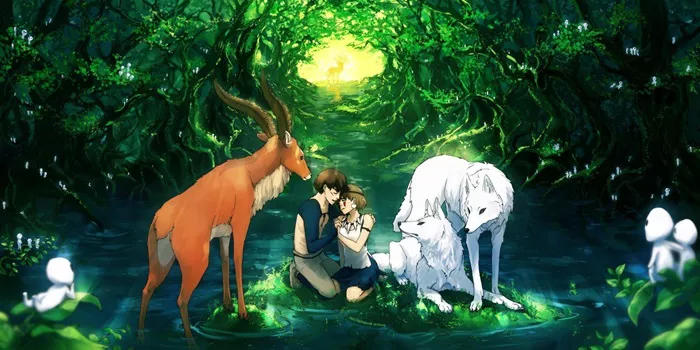Princess Mononoke,” one of the most acclaimed films directed by Hayao Miyazaki and produced by Studio Ghibli, stands out as a monumental work in the world of animation. Released in 1997, it captivated audiences globally with its compelling narrative, complex characters, and a profound message concerning environmental conservation and the conflict between industrial progress and nature. Given its intricate storytelling and deep thematic content, one might wonder whether “Princess Mononoke” is based on a book or derived from traditional folklore. This article explores the origins of “Princess Mononoke”, examining the inspirations behind its creation and clarifying its sources.
The Creative Genius of Hayao Miyazaki
Hayao Miyazaki as the Sole Creator
Hayao Miyazaki is not only the director but also the writer of “Princess Mononoke.” Unlike many films that are adaptations of novels or other forms of literature, “Princess Mononoke” is an original work created by Miyazaki’s imaginative mind. The inception of its plot, characters, and setting sprang from his profound concerns about human environmental impact and the moral ambiguities of the industrial world.
Inspirational Sources Behind the Film
While “Princess Mononoke” is not directly based on any specific book, Miyazaki drew inspiration from various sources, including Japanese history, mythology, and his own philosophical musings. His fascination with the Muromachi period (approximately 1336 to 1573), a time of immense cultural and artistic change, significantly influenced the film’s historical backdrop. This period was marked by the emergence of the samurai class and the conflicts that led to the eventual unification of Japan.
Cultural and Mythological Inspirations
Influence of Japanese Folklore
Japanese folklore and Shinto beliefs play a critical role in shaping the spiritual depth of “Princess Mononoke.” The film features an array of gods and spirits inspired by Shinto, which is deeply intertwined with Japan’s natural landscapes and phenomena. The concept of “kami,” which refers to spirits or phenomena that are worshipped in the Shinto religion, is evident in the portrayal of the Forest Spirit, a pivotal character that embodies the essence of life and death within the film.
Ainu and Emishi Cultural References
Miyazaki also incorporated elements from the histories of the Ainu and Emishi peoples, indigenous groups in Japan known for their distinct cultural identities and their conflicts with the expanding powers of the Japanese central government during and after the Muromachi period. The character Ashitaka, hailing from the Emishi tribe, represents the struggles faced by these communities, adding a layer of historical context to the environmental themes.
Environmental Themes and Philosophical Undertones
Man vs. Nature: A Recurrent Theme in Miyazaki’s Works
“Princess Mononoke” addresses the conflict between industrial development and the natural world, a theme recurrent in many of Miyazaki’s films. The story does not merely depict a battle between good and evil but rather presents a complex interaction where every character, including Lady Eboshi and the inhabitants of Iron Town, has justifiable motives and beliefs. This nuanced portrayal invites viewers to reflect on the impact of human actions on the environment and the often irreversible damage inflicted upon ecosystems in the name of progress.
Philosophical Exploration of Progress and Harmony
The philosophical backbone of “Princess Mononoke” challenges the notion of what it means to live in harmony with nature. It questions if true progress can be achieved at the expense of the environment and explores alternative paths where humans might coexist with the natural world without domination and destruction.
Miyazaki’s Artistic Process
From Initial Concept to Screen
The creation of “Princess Mononoke” was an arduous process that involved extensive research, sketches, and storyboarding. Miyazaki’s meticulous attention to detail is evident in the lush, intricate settings and the fluidity of the animation, which took nearly three years to complete. His hands-on approach in drawing thousands of frames by hand significantly contributed to the film’s visual and emotional depth.
Influence of Western Literature and Film
While primarily influenced by Japanese culture and history, Miyazaki’s work has also been shaped by Western literature and cinema. Elements reminiscent of epic tales and American Westerns can be seen in “Princess Mononoke,” reflecting Miyazaki’s wide range of influences and his ability to weave them into unique narratives. This synthesis of Eastern and Western elements helped the film resonate with a global audience, transcending cultural barriers and highlighting universal themes.
Conclusion: A Standalone Masterpiece
“Princess Mononoke” is not an adaptation of a specific book but is a unique creation that reflects Hayao Miyazaki’s personal concerns, extensive historical knowledge, and rich imagination. Its story is a tapestry woven from various cultural, mythological, and environmental threads, making it a timeless film that continues to inspire and provoke thought across different generations. As we move forward in an increasingly industrialized world, “Princess Mononoke” remains relevant, reminding us of the delicate balance between human endeavors and the natural world.


